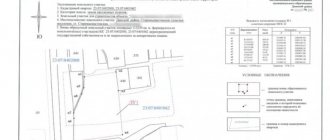The concept of land consolidation
When two (or more) adjacent land plots are combined into one, a new plot appears in the official state cadastre, and the combined adjacent ones cease to exist as real estate. Title to the new lot is given to the owner of the original lots, and if the original lots were owned by different people, then those people will have the new combined lot in common ownership.
It is necessary to take into account that according to the Land Code of the Russian Federation, the merger of land plots granted ownership on an indefinite right of use, lifelong inherited possession or by the right of free use to different persons is not allowed, but if all these plots are owned by one person, then he may well combine them according to to your will.
Consolidation of land plots: main provisions and reasons
The consolidation of land plots occurs upon a written application from the owner. It is worth considering that the type of permitted use of the land and its intended purpose remain unchanged.
According to paragraph 1 of Art. 11.6 of the Land Code of the Russian Federation, only adjacent plots of land are allowed to be combined. In this case, it does not matter whether there is one owner of the plots or several. In the first case, the owner of the combined plot will be one, in the second – the property will be recognized as common, that is, shared.
Both legal entities and individuals can combine adjacent land plots into one.
The main reasons why merging areas may be required are:
- The desire to increase the market value of land. One plot with a large usable area can be sold for more than two small plots of land.
- The desire to simplify the property accounting procedure. This reason is often used by organizations to simplify tax accounting and transfer payments to the Federal Tax Service.
- The desire of the owners of several plots to combine them into one for the construction of a residential building or cottage. This is required to avoid problems with current legislation regarding obtaining a development permit.
In order to be able to combine plots, it is necessary to take into account the legal requirements regarding land plots. This will be discussed further.
Conditions for combining land plots
The legislation specifically stipulates the requirements for initial sites, in particular:
- in addition to their contiguity, boundaries should be established in accordance with government regulations;
- In these territories, characteristic points must be fixed with due accuracy. If it turns out that the accuracy is lower than required by the standards, it will be necessary to further clarify the boundary points of such a section;
- The merged plots must belong to the same land category. In some cases, when the owner of a new plot will choose the type of its use, this rule may be violated;
- the initial sites must be geographically located in the same locality (municipal entity);
- if it is planned to unite land plots that are provided for indefinite use, inherited for lifelong ownership or are in urgent free use, they must have one legal holder;
- when merging plots, the permissibility of using the real estate located on them must be maintained;
- the formation of new plots should not cause disadvantages in the area that impede the protection of lands and their rational use: wedging and interspersing, brokenness and striping, and also violate the requirements,
- established in the Land Code of Russia and federal legislation.
In addition, the legislation separately stipulates the requirements for the maximum limit of land size, which must be observed for new territories.
Features of land consolidation in 2021
Consolidation of land plots is a fairly common procedure and is popular. There are lovers of fresh country air, who often lack six acres, and there are neighbors of such lovers, for whom the dacha is like a burden: either pay the fees, or mow the grass, and they live far away. So it turns out to come to an agreement like a neighbor, like one of our own. Features of the consolidation of land plots in 2021 are due to the adoption of the law on gardeners and vegetable gardeners and amendments to the Land Code. The amendments in particular affected the names of land plots: instead of dachas, now gardens and vegetable gardens. And in order to figure out whether it is possible to combine land plots in 2021 and how to do this without breaking the law, we will analyze it step by step.
The owner's decision to combine land plots into one
If the owner wants to combine the land plots belonging to him into one territory, then he cannot do without the help of specialists in order to comply with all the rules specified in the regulations, but also to embody all his own ideas. Indeed, in each case, legislative nuances of such a procedure may appear.
To carry out the consolidation of land plots in any option, it will be necessary to carry out preliminary surveying, which is, in fact, a set of works, which, among other things, includes calling cadastral service workers to the site to carry out geodetic measurements using equipment using satellites and fixing the boundaries of the new plot with conventional boundary lines signs.
Based on the results of the procedure, a boundary document (plan) is drawn up that complies with the standards prescribed by law.
Cost of drawing up a boundary plan for merging a land plot
As mentioned above, most often measurements on the ground are not needed for this type of boundary plan. This means that the cost of work will be low. However, you should not chase cheap offers on the geodetic services market. After all, land is becoming more and more expensive, and mistakes in its design may not be worth the cost of the work.
Our company will prepare a boundary plan for the consolidation of a land plot in Moscow and the Moscow region from 8000 rubles .
Even if you do not dare to contact our company, do not fall for big discounts and super-profitable offers - most likely these are scammers or unscrupulous performers. High-quality work will not cost “the cheapest.”
Prices for surveying
Our social networks:
Phone: 8 (903) 253-35-84, Ilya
Cadastral registration of a consolidated plot
After carrying out cadastral work and drawing up a boundary plan, you can proceed to the legal registration of the new site in the State Property Committee. In this case, the provisions listed in the Cadastre Law (Federal Law No. 221-FZ) must be observed, namely:
- information about the newly formed territory entered into the cadastre is initially temporary;
- all existing restrictions (as well as encumbrances and easements) of the original plots (if they did not arise as a result of the signing of contracts) in relation to the new plot are preserved to the same extent;
- if the new site was not assigned an address according to the established rules, a detailed description of its location is indicated in the State Property Committee.
If we talk about obtaining an address for the land, it is more convenient to do this after the geodetic work is completed, but before the cadastral registration process begins, since it takes less time for the owner of the new territory. However, the law does not prohibit assigning an address to a new plot after its cadastral registration.
The consolidation of plots becomes legally finalized when the state registration of ownership of the new plot takes place, and the accounting authorities, having received information about its implementation, assign the status of “archive” to the previously separated plots.
The procedure for combining land plots and documents for its registration
To unite land plots, each of them must be officially registered in the State Property Committee, as well as in the register of ownership of real estate. Registration must be supported by appropriate documentation. The merged areas must have the same purpose and common features.
List of required documents:
- Documents on ownership (state act on the right of ownership (use), lease agreement, certificate) and the presence of a cadastral number.
- Documents confirming the emergence of proprietary rights (purchase and sale agreement, certificate of inheritance, agreement on gift, exchange or lifelong maintenance, decision of executive authorities or court, as well as local council, administration order, etc.).
- Personal documents of the owner (user) of the plot: for citizens - a copy of the passport (first and second page and registration) and TIN code; for legal entities - a registration certificate, a copy of the Charter and a tax payer certificate and a certificate from the USREOU.
- If the site is developed, then documents confirming that the buildings have registered owners.
- For non-agricultural lands - a certificate of address confirmation.
If the plot is located within the boundaries of a garden plot, then documents from its managers will be required (certificate with the plot number, certificate of the garden society, certificate confirming registration, copies of the Charter, tax payer certificates, certificate of the garden society from the Unified State Register of Enterprises and Organizations).
The procedure for merging areas will be as follows:
- writing a statement of consent with the association from a notary, signing an agreement with land managers;
- preparation of documentation and its approval;
- obtaining an extract from the State Property Committee and a certificate of ownership.
Necessary conditions for merging plots
There are quite a lot of conditions and it is worth going into detail about each of them:
- The plots must have a common border with a distance of at least the norms established by the Law, that is, they must be adjacent with a length of the common border of at least 1 meter.
- The original land plots must be registered in the cadastral register and their boundaries must be determined in compliance with accuracy standards. This parameter can be viewed in the cadastral extract (if the old one remains) in section KV.6 or in the extract from the Unified State Register of Real Estate on the last sheet. For reference, in the lands of populated areas it should be 0.1 m; if this is SNT on farmland - no more than 0.2 m. If the number is higher, or nothing is written at all, you must first prepare a boundary plan to clarify the boundaries. Make changes to the cadastre on its basis and only then proceed to the formation of a land plot through merger.
First of all, this point concerns owners of land plots in New Moscow. Being the Moscow region, the accuracy of determining the location of boundary signs was 0.3 m. Now it is 0.1 m - now this is Moscow (populated area). So it turns out that almost all sites in this area do not meet the standard accuracy.
- The resulting lot must comply with the maximum lot size standards established by local governments, if any, for this type of permitted use. In Moscow, for example, there are no such norms.
- The original plots must have the same type of permitted use (LPH, gardening, individual housing construction, etc.) and, accordingly, the category of land (settlement lands, agricultural purposes, etc.). They must also belong to the same administrative-territorial entity. To put it simply, they must be located in the same cadastral quarter. This information can be found on a public cadastral map.
- Written consent of the owner(s) of the original plots for the merger is required
If all these conditions are met, you can proceed.
Cancellation of land consolidation
According to the Federal Law on Cadastre (No. 221-FZ), deleting information about a consolidated land plot from the State Property Committee is possible, since when a new plot is registered in the cadastre, according to the law, temporary information is entered, which is such until the rights to the formed the object will be registered officially or after five years from the date of registration of the object.
After this, deregistration of the plot is possible only when it is converted real estate and, in accordance with the law, the decision on its formation can be canceled.
Sequence of procedures
If you are convinced that the neighboring properties meet the above requirements, then it is time to go to the Land Committee, which has jurisdiction over the land. Once in place, you need to fill out an application form to merge two land plots into one. It is accompanied by a set of documents, including:
- civil passport of the owner of the territories;
- title papers for real estate;
- cadastral passports of objects;
- location diagram of adjacent lands;
- extract from the Unified State Register.
Individual entrepreneurs additionally attach a certificate confirming registration with the tax authority. If the applicant acts as a representative of the owner, then he must confirm his authority with a valid notarized power of attorney.
The application is reviewed by the local administration within a calendar month. The question is asked at a meeting of the special land commission. After the discussion, the specialists prepare a draft decision, which is submitted for approval to the chief architect of the district. If a positive decision is made, the owner of the property receives a resolution endorsed by the autograph of the head of the local administration. If the answer is negative, the applicant receives a notification with a reasoned refusal.
If it is possible to combine adjacent plots, then it is necessary to re-marry the site in order to identify the characteristic points of a new, large real estate property. After this, you can register the right to use and dispose of the object.
Did you like the article? Watch an interesting video about what an ordinary German dacha is like.
Cost of merging plots
No specialist will be able to tell you exactly how much the procedure for connecting land plots might cost unless he has information about your specific plots and the situation with documents and other information about what needs to be done. There are several criteria for assessing the cost of cadastral services, such as:
- complexity of the work ahead;
- area of objects;
- Accessibility by road;
- additional costs for the provision of related services;
- the presence or absence of any documents.
After a cadastral service specialist has visited the site, he will be able to assess in more detail the scope of the upcoming work and tell you the exact (or estimated) price that you will need to pay for preparing your plots for cadastral registration.







